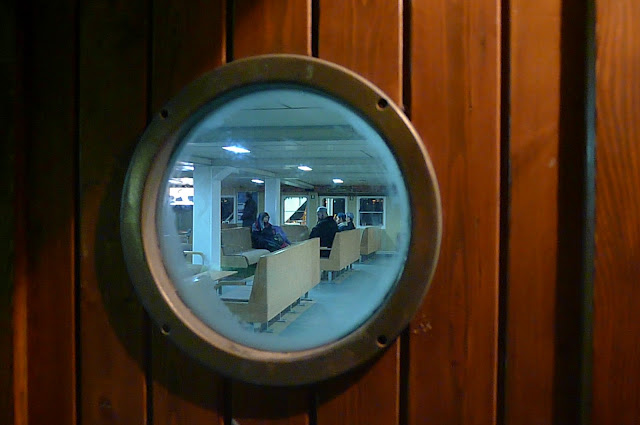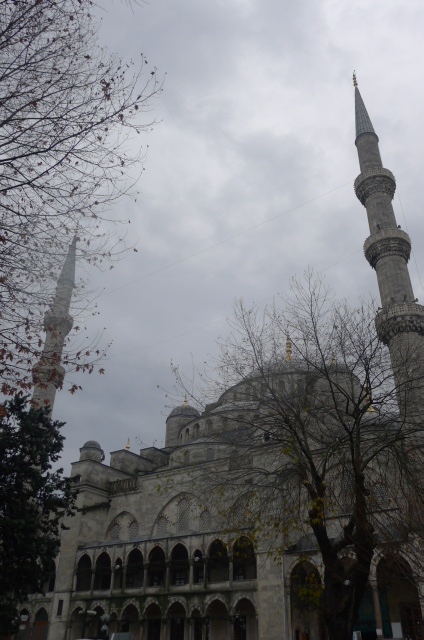| Ziarah Maqam of Sultan Ahmed I |
Holy Beard of Prophet Muhammad (pbuh)
Viewing the Holy Beard at Maqam Sultan Ahmed
 |
| Ziarah Maqam Sultan Ahmed I |
 | |
The Maqam of Sultan Ahmed I, the Blue Mosque’s great patron, is on the north side of the mosque facing Sultan Ahmet Park. Sultan Ahmed, who had ascended to the imperial throne at the aged of 13, passed away one year after the mosque was constructed, at the aged of only 27.
Sultan Ahmed Mosque or
The Blue Mosque
 |
| Bro Razib in front of the Blue Mosque |
The Dome
The Entrance
 |
| The reason why it is called the Blue Mosque |
It was built from 1609 to 1616, during the rule of Sultan Ahmed I. Like many other mosques, it also comprises a tomb of the founder, a madrasah and a hospice. While still used as a mosque, the Sultan Ahmed Mosque has also become a popular tourist attraction. The design of the Sultan Ahmed Mosque is the culmination of two centuries of both Ottoman mosque and Byzantine church development. It incorporates some Byzantine elements of the neighboring Hagia Sophia with traditional Islamic architecture and is considered to be the last great mosque of the classical period. The architect has ably synthesized the ideas of his master Ibnu Sinan, aiming for overwhelming size, majesty and splendour.It has 6 minarates along with 8 domes and 1 main one.
Ziarah, Maqam Shaykh Shahrafuddin Ad - Daghestani (q), the 38th Shaykh of the Golden Chain of the Distinguished Naqshbandi Tariqah
 | |
| Shaykh Shahrafuddin Ad-Daghestani (q) |
Road to the Maqam
The Maqam of Shaykh Shahrafuddin Ad Daghestani in Rashadiya, Gunekoy, about 2 hrs journey from Istanbul
 | ||
| At the Entrance of the Maqam |
Rashadiya Public Cemetery
Shaykh Shahrafuddin Ad Daghestani was the advisor of Sultan Abdul Hamid. He was Shaykh ul-Islam of the Ottoman Empire. He was respected by the government, even in the new Turkish regime at the time of Ataturk. He was one of two shaykhs who were allowed to wear their turbans in a time when wearing the turban was generally and completely forbidden and practicing Islam in its outward forms was utterly banned. Shaykh Sharafuddin used to reach a state of Vision in which he would bear the Manifestation of Majesty; at that time, no one could look into his eyes. If they did they would faint or be powerfully attracted to him. For that reason, when he entered that state, he used to cover his eyes with a veil (burqa). Shaykh Sharafuddin wrote many, many books, but unfortunately they were burned during the Balkan War. Still many manuscripts remain among the family of Shaykh Sharafuddin, in which are contained many secrets of the Naqshbandi orders, and often the disciples go to them to read these books.
The Derga of Shaykh Shahrafiddin Ad - Daghestani (q)
 |
| Inside the Derga |
 |
| The seat where Shaykh Shahrafuddin (q) used to sit to give his Sohba |
 |
| 93 years old, Daughter in Law of Shaykh Shahrafuddin Ad Daghestani (q) |
 |
| Group Photo
The Blessed Town of Rashadiya
|
 | ||
| Shaykh Ya'kub our Guide with Shaykh Razip and Bro Achmad in a Ferry to Rashadiya |
Shaykh Shakur on a Ferry from Rashadiya
Road to Rashadiya
Rashadiya Town
 |
| Water Fountain dated back from Ottoman Period |
 |
| Courtyard |
 |
| View from a Mosque |
Bro Fedly infront of a Mosque
Rashadiya Town Square
 |
| On a Ferry from Rashadiyah |
 |
| From Rashadiyah back to Istanbul Maqam of Prophet Yusha (as) in Beykoz |
 | ||
 |
| Shaykh Shakur Making dua at the Maqam |
Mosque on Yusha Hill
Overlooking the Bosphorus River
Maqam of Shaykh Jamaluddin Al-Ghumuqi Al Husayni (q) the 35th Shaykh of the Golden Chain of the Distinguished Naqshbandi Tariqah
 |
| Shaykh Jamaluddin Al-Ghumuqi Al Husayni |
 |
| Bro Achmad Making Dua |
Ziarah Maqam Akbaba Sultan Turbesi
Yeralti Camii (Underground Mosque) and the Maqam of the Sahabah in Karaköy
 |
| The Underground Mosque is located at Karantina Sok, Karaköy |
 | ||
| Maqam of Sufyan Bin Uyeyne (r.a) located inside the Mosque |
 | |
| Maqam of two Sahabah who passed on duirng the Arab Seige |
 |
| Inside the Mosque |
 |
| The Mosque's Mimbar |
This underground mosque occupies the crypt of a former castle that was probably associated with the Castle of Galata. Tradition has it that the colossal chain used to blockade ships from entering the Golden Horn was anchored here. What remained of the ruins (the castle was destroyed during the Ottoman conquest) was converted into a mosque. The space is created by a low-ceilinged, vaulted maze supported by squat pillars. The columns are arranged in six rows of nine, forming little compartments for private prayer. Located in a side are the Maqam of Sahabah who passed away during the first Arab siege. The location of these graves was revealed to a Naqshbandi's Dervish in a dream in 1640. It wasn't until later, in 1757, that the cellar space was converted into a mosque. It is also known as the Kursunlu Mahzen Camii (Gunpowder Warehouse Mosque).
Ziarah Maqam Aziz Mahmud Hudayi in Üsküdar
 | |
| At the Entrance |
 |
| Making Dua |
Hazret Aziz Mahmud Hudayi (q) (1541–1628), (b. Şereflikoçhisar, d. Üsküdar), is amongst the most famous sufi saints of Turkey, mystic, poet, composer, author, statesman and Islamic scholar. He was the Sheikh of Sultan Ahmed I who constructed the famous Blue Mosque and especially gained the respect of Sultan Murat III. He read the first Friday prayer in this Mosque on its opening. Born in Şereflikoçhisar, he completed his studies in a medrese in Istanbul. Aziz Mahmud Hudayi served as Qadi in Edirne, Egypt, Sham (Syria), and Bursa. He was a murid and khalifah of Üftade Hazretleri. He wrote about thirty works, seven of which are in Turkish. His dua, "Those who visit us when we are alive, and those who visit our grave after our death and read the Fatiha when passing by our tomb are ours. May those who love us not drown at sea, may they not suffer poverty in their old age, may they not pass away without saving their faith," has prompted many sailors of the Ottoman Empire to visit his grave before going out to sea. Aziz Mahmud Hudayi died in Üsküdar, Istanbul and is buried next to his mosque. He is something of the patron saint of Asian Istanbul.





































